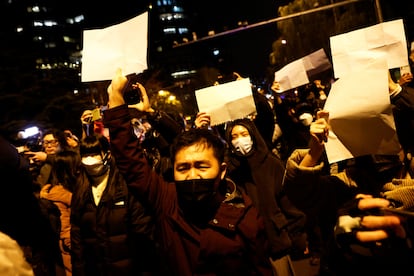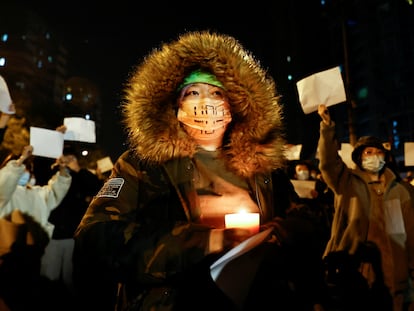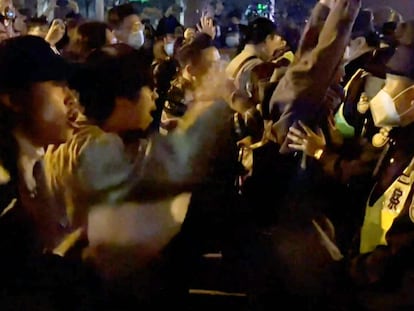The ‘white paper’ revolt against China’s zero-Covid policy
How blank sheets became a symbol of protest against government censorship


On a Sunday night in late November, hundreds of demonstrators in Beijing protesting their government’s draconian anti-Covid measures waved blank sheets of white paper at the cameras as they stood before the police barriers blocking their way. Simple and cheap blank sheets of paper used in copiers and printers all over the world have become unlikely protest symbols during some of China’s biggest and most widespread displays of discontent in decades. It’s a symbol of fury with President Xi Jinping’s iron-fisted zero-Covid policy that has once again locked down major cities all over the country.
The blank white paper is a metaphor for the harsh censorship of critical social media posts and news articles, and an ironic condemnation of the absence of freedom of speech in China. “It means we are protesting China’s censorship,” said a demonstrator at the November 27 rally near Beijing’s Liangma River. “It says that we’ve never had freedom of speech or democracy. As Chinese citizens, we’re not allowed to comment on any political issue, especially if it’s negative or critical.”
As the protests grew, the “A4Revolution” hashtag rippled through social media, a reference to the size A4 paper used by the demonstrators. The blank white paper has somehow become a universal symbol of the complete freedom that marks the beginning of any new creation.

But blank white paper as a protest symbol is not new, nor does it pertain exclusively to China’s zero-Covid measures. In 2020, it was used by Hong Kong dissidents to symbolize the political slogans banned under the new National Security Law, which punishes people convicted of terrorist, seditious or subversive activities with life sentences. On November 28, blank sheets of paper appeared once again in Hong Kong in the hands of activists protesting the intense show of force by police to quell demonstrations in Shanghai and Beijing.
Soon after Russia invaded Ukraine in February, dissidents used blank white paper to protest the harsh repression of Vladimir Putin’s regime, which blocked the dissemination of information that contradicted the official narrative about the invasion. In March, a Russian citizen was arrested for holding up a blank sheet of paper after an absurd, Kafkaesque exchange with the police. “I demand that you stop your illegal activity,” said the police officer after listing all the regulations he was violating by not displaying any message. “I will not,” said the demonstrator before he was hustled away by two riot police.
The absence of a message is the message, a synopsis of the protesters’ simple demands. “We want a normal life again,” said a 22-year-old student in Beijing who went by the pseudonym Peach. The young man was carrying a ream of paper that he handed out to any empty-handed demonstrators. Many used the paper to cover their faces so they wouldn’t be identified in photos. Besides all the international press covering the protests, Chinese security personnel were ever-present, recording every move.
In the heat of the protests, Peach didn’t say what he wanted the white paper to symbolize, but he later texted, “Just like people think of LGBTQ+ when they see the rainbow flag, I hope they will think of all the voices that have been blanked out by censorship. Handing out white paper is not just an expression, but also a kind of protection, because white space is the only thing that cannot be silenced. Emptiness and white also correspond to our demands: freedom and a return to everyday life.”
The Chinese have extensive experience in circumventing censorship, and have come up with some ingenious and surprisingly imaginative solutions. To avoid censors attuned to certain sensitive words, Chinese netizens often use clever allusions in social media posts. For example, references to the “Me too” movement often use the 米 兔 characters, which is pronounced “meetoo” in Chinese but actually means “rice rabbit.”
Surveillance and control is so intense in China that people often avoid saying President Xi Jinping’s name in public. In a circumlocution reminiscent of Harry Potter talking to his friends about Lord Voldemort, the president is referred to as the “one we all know,” the “unnamed one” or the “one at the top.”
But not every sheet is blank. Some students at Tsinghua University in Beijing wrote equations developed by American economist Milton Friedman, whose surname in Chinese sounds like “free man.” Paradoxically, China’s national anthem is also sung at the demonstrations because of its powerful anti-slavery message. When the anthem cries out, “Rise up! Rise up! Rise up!”, the singing gets louder, and everyone raise their blank sheets of paper to emphasize the seemingly empty but very meaningful message of rejection of the anti-Covid lockdowns.
Tu suscripción se está usando en otro dispositivo
¿Quieres añadir otro usuario a tu suscripción?
Si continúas leyendo en este dispositivo, no se podrá leer en el otro.
FlechaTu suscripción se está usando en otro dispositivo y solo puedes acceder a EL PAÍS desde un dispositivo a la vez.
Si quieres compartir tu cuenta, cambia tu suscripción a la modalidad Premium, así podrás añadir otro usuario. Cada uno accederá con su propia cuenta de email, lo que os permitirá personalizar vuestra experiencia en EL PAÍS.
¿Tienes una suscripción de empresa? Accede aquí para contratar más cuentas.
En el caso de no saber quién está usando tu cuenta, te recomendamos cambiar tu contraseña aquí.
Si decides continuar compartiendo tu cuenta, este mensaje se mostrará en tu dispositivo y en el de la otra persona que está usando tu cuenta de forma indefinida, afectando a tu experiencia de lectura. Puedes consultar aquí los términos y condiciones de la suscripción digital.
More information
Archived In
Últimas noticias
The complicated life of Francesca Albanese: A rising figure in Italy but barred from every bank by Trump’s sanctions
How Japan is trying to avert ‘digital defeat’
Half of Scotland is in the hands of 420 property owners
Reinhard Genzel, Nobel laureate in physics: ‘One-minute videos will never give you the truth’
Most viewed
- Pablo Escobar’s hippos: A serious environmental problem, 40 years on
- Why we lost the habit of sleeping in two segments and how that changed our sense of time
- Charles Dubouloz, mountaineering star, retires at 36 with a farewell tour inspired by Walter Bonatti
- Reinhard Genzel, Nobel laureate in physics: ‘One-minute videos will never give you the truth’
- The Florida Keys tourist paradise is besieged by immigration agents: ‘We’ve never seen anything like this’










































